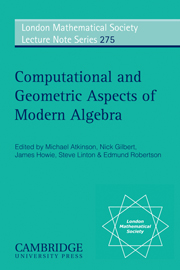Book contents
- Frontmatter
- Contents
- Foreword
- Participants
- 1 Lie Methods in Growth of Groups and Groups of Finite Width
- 2 Translation numbers of groups acting on quasiconvex spaces
- 3 On a term rewriting system controlled by sequences of integers
- 4 On certain finite generalized tetrahedron groups
- 5 Efficient computation in word-hyperbolic groups
- 6 Constructing hyperbolic manifolds
- 7 Computing in groups with exponent six
- 8 Rewriting as a special case of non-commutative Gröbner basis theory
- 9 Detecting 3-manifold presentations
- 10 In search of a word with special combinatorial properties
- 11 Cancellation diagrams with non-positive curvature
- 12 Some Applications of Prefix-Rewriting in Monoids, Groups, and Rings
- 13 Verallgemeinerte Biasinvarianten und ihre Berechnung
- 14 On groups which act freely and properly on finite dimensional homotopy spheres
- 15 On Confinal Dynamics of Rooted Tree Automorphisms
- 16 An asymptotic invariant of surface groups
- 17 A cutpoint tree for a continuum
- 18 Generalised triangle groups of type (2, m, 2)
11 - Cancellation diagrams with non-positive curvature
Published online by Cambridge University Press: 06 July 2010
- Frontmatter
- Contents
- Foreword
- Participants
- 1 Lie Methods in Growth of Groups and Groups of Finite Width
- 2 Translation numbers of groups acting on quasiconvex spaces
- 3 On a term rewriting system controlled by sequences of integers
- 4 On certain finite generalized tetrahedron groups
- 5 Efficient computation in word-hyperbolic groups
- 6 Constructing hyperbolic manifolds
- 7 Computing in groups with exponent six
- 8 Rewriting as a special case of non-commutative Gröbner basis theory
- 9 Detecting 3-manifold presentations
- 10 In search of a word with special combinatorial properties
- 11 Cancellation diagrams with non-positive curvature
- 12 Some Applications of Prefix-Rewriting in Monoids, Groups, and Rings
- 13 Verallgemeinerte Biasinvarianten und ihre Berechnung
- 14 On groups which act freely and properly on finite dimensional homotopy spheres
- 15 On Confinal Dynamics of Rooted Tree Automorphisms
- 16 An asymptotic invariant of surface groups
- 17 A cutpoint tree for a continuum
- 18 Generalised triangle groups of type (2, m, 2)
Summary
Abstract. We define small cancellation conditions W* and W representing non-positive curvature in cancellation diagrams. Each of these two conditions, which are dual to each other, generalizes the classical small cancellation conditions C(6), C(4) T(4), C(3) T(6). W also contains the small cancellation condition W(6) of Juhasz. Our main result is the solution of the conjugacy problem for groups with a presentation satisfying W* or W. Its proof uses the geometry of non-positively curved piecewise Euclidean complexes developed by Bridson. Following a sketch of Gersten, we also give a detailed proof of the solvability of the word problem for such groups by a quadratic isoperimetric inequality.
THE CONDITIONS W* AND W
Let P = 〈x1,…, xn |R1, …, Rm〉 be a finite presentation of the group G. We always assume that each relator Ri is cyclically reduced and no relator is the trivial word or a cyclic permutation of another relator or of the inverse of another relator. (By “relator” we always mean a denning relator of the presentation.) Let F be the free group on the generators. Kp denotes the standard 2–complex modeled on P.
The Whitehead graph Wp of Kp is the boundary of a regular neighborhood of the only vertex of Kp. For each generator xi of P it has two vertices +xi and –xi which correspond to the beginning and the end of the oriented loop labeled Xi in Kp.
Information
- Type
- Chapter
- Information
- Computational and Geometric Aspects of Modern Algebra , pp. 128 - 149Publisher: Cambridge University PressPrint publication year: 2000
Accessibility standard: Unknown
Why this information is here
This section outlines the accessibility features of this content - including support for screen readers, full keyboard navigation and high-contrast display options. This may not be relevant for you.Accessibility Information
- 1
- Cited by
